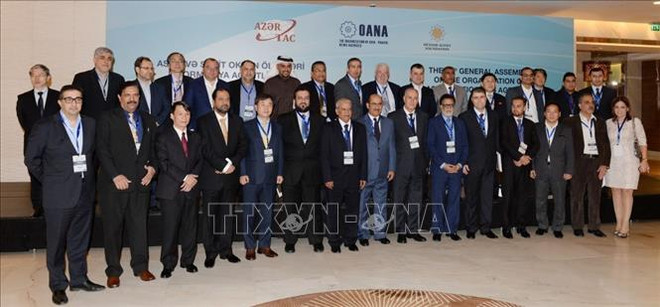 Representatives of OANA member agencies posed for a group photo at the 16th OANA General Assembly in Baku, Azerbaijan, in November 2016, which discussed measures to address challenges facing modern media. (Photo: VNA)
Representatives of OANA member agencies posed for a group photo at the 16th OANA General Assembly in Baku, Azerbaijan, in November 2016, which discussed measures to address challenges facing modern media. (Photo: VNA)Hanoi (VNA) – Members of the Organisation of Asia-Pacific News Agencies(OANA) have shared their experience, particularly the use of up-to-datetechnology, in addressing challenges facing modern press, on the occasion ofthe 44th OANA Executive Board Meeting in Hanoi from April 18-20.
Accordingto the Islamic Republic News Agency (IRNA) of Iran, in response to the latesttrends among the audience and taking technological developments intoconsideration, IRNA has increased its active engagement in the web and socialnetworks through its multimedia services.
FromApril 2018 to March 2019, in a period of 11 months, the agency has published125,208 photo frames, including both photo reports and images that are attachedto news articles.
IRNApublished 2,881 videos in the same period. The videos have been posted both onIRNA official website and on Aparat—an Iranian video sharing site like Youtube.
Duringthat period of time, IRNA also published 294 infographics and 574 audioreports.
IRNAPersian page on Instagram has 155,000 followers. This number is remarkablesince Associate Press and AFP have 342,000 and 439,000 followers on Instagramrespectively.
Furthermore,IRNA releases the latest news through Twitter and the Iranian network ofSoroush.
Atthe same time, IRNA produces long reports, essays and news bulletins for itsspecific audience groups. In short, IRNA tries to address the needs ofdifferent groups of society via a vast range of products.
Meanwhile, the Montsame News Agency ofMongolia said to cope with the shift of new content consumption behavior,focusing on video content and YouTube platform, the agency has successfullybroadcasted news content through Twitter and Facebook platforms as fromSeptember 2017.
Noting that the main criterion forbroadcasting information using YouTube.com platform is speed, especially inbreaking news, and quality issues, the agency stressed the importance of increasingbreaking news and video news. Video news are taken from the original source andthere will be no chance to be fake. And it would help to solve such issues as fakenews and verified news, and how to win back trust of costumers who often trust basicinformation, the agency said.
To consolidate the position of the OANAmember agencies in the global news network, the agency suggested improving the usage of the OANA’s website, increasing the supply of videonews to OANA websites, and paying attention to developing Facebook and Twitter pages.
China’sXinhua News Agency pointed out that from the world perspective, it’s gettingincreasingly obvious that the news audience have been moving to the internet,especially mobile internet, with the number of global internet users breaching4 billion.
SunYong, President of Xinhua’s Asia-Pacific Bureau, said the agency has beenworking hard to innovate their news products, changing from mainly servingtraditional media to various types of users and their different needs.
Ithas rolled out different services for new media and short video media, andincreased mobile, visual, intelligent and digital products and so on.Currently, Xinhua produces an average of 100 short videos every day.
Theagency builds technological construction as its core competitive power, and nowhas a technology team of nearly 1,000 people.
Ithas established an all-media reporting, editing and releasing platform,combining multiple functions together including planning, news gathering, manufacturing,feed back analysis, and data statistics. The platform is now being usedthroughout the agency.
Xinhuahas also built an open news live broadcast “Cloud Platform”. Now more than3,100 Chinese media organizations have joined the platform, and the agencyconducts nearly 400 live broadcasts of various kinds every day.
SunYong said the agency has cooperated with China’s biggest e-commerce companyAlibaba and set up a new media technology company, and launched a “Media Brain”platform, the first-of-its-kindin China that brings cloud computing, the Internet of Things, BigData and AI technology into news production.
On the platform, the news gathering, productionand distribution of a video are completely undertaken by machines, and thewhole process only takes a few seconds, he said.-VNA



























